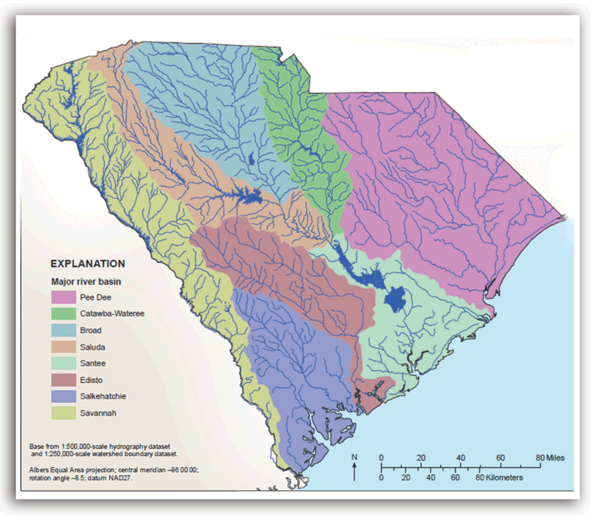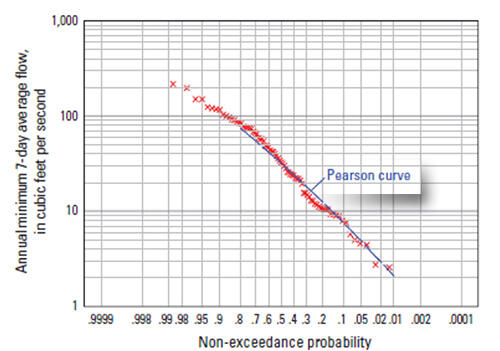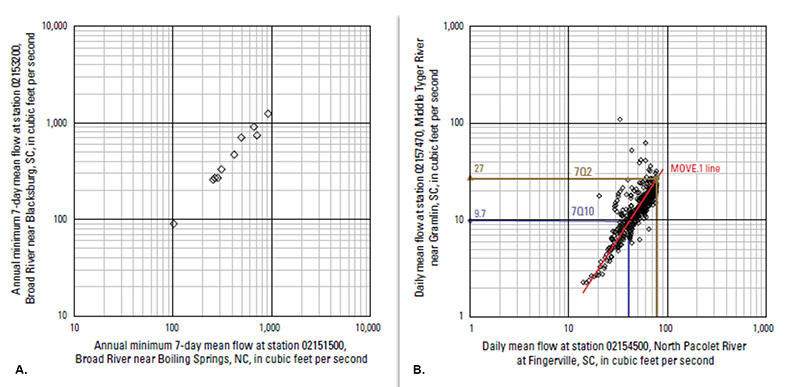Low-Flow Frequency and Flow Duration Statistics at Continuous-Record Gages in South Carolina Active
South Carolina State agencies use low-flow statistics for many applications, including determining waste-load allocations for point sources, development of total maximum daily loads (TMDLs) for streams, determining the quantity of water that can be safely withdrawn from a particular stream, and preparing the State Water Plan. This project will monitor the low-flow frequency and duration statistics at continuous-record stations in several basins in South Carolina.' to "Low-flow frequency and duration statistics were determined at continuous-record stations throughout South Carolina and are available in a series of on-line reports.
INTRODUCTION

South Carolina State agencies, such as the South Carolina Department of Health and Environmental Control (SCDHEC) and the South Carolina Department of Natural Resources, currently use low-flow statistics for many applications, including determining waste-load allocations for point sources, development of total maximum daily loads (TMDLs) for streams, determining the quantity of water that can be safely withdrawn from a particular stream, and preparing the State Water Plan. In addition, low-flow statistics are useful for improving the general level of understanding of natural and regulated stream systems. The two most recent droughts in South Carolina, during 1998–2002 and 2006–2009, have heightened the awareness of the importance of having up-to-date statistics for making such critical decisions.
Table 1. South Carolina Department of Health and Environmental Control (SCDHEC) basins.
- Pee Dee
- Broad
- Saluda and Edisto
- Catawba-Wateree and Santee
- Savannah and Salkehatchie
Prior to this investigation, low-flow statistics in South Carolina had not been updated in a systematic way since 1987. In 2008, the U.S. Geological Survey (USGS), in cooperation with the SCDHEC, initiated a study to update low-flow characteristics at continuous-record streamgaging stations operated by the USGS in South Carolina. This investigation coincides with the SCDHEC Watershed Water Quality Management Strategy (WWQMS) for monitoring and assessment of the eight major basins in South Carolina (fig. 1), which is done every 5 years (South Carolina Department of Health and Environmental Control, 2009). Consequently, several of the basins are grouped together to facilitate the 5-year rotation.
ANALYTICAL APPROACH
The low-flow frequency and duration statistics are being analyzed at continuous-record (CR) stations based on four categories of stations:

1. Long-term stations (typically defined as 30 years or more of CR data);
2. Short-term stations (more than 10 years of record but less than 30);
3. Stations with more than 5 years of CR record but less than 10; and
4. Regulated stations.
For the long-term stations, the low-flow frequency statistics are computed by fitting the logarithms of a series of annual minimum N-day average flows to a Pearson Type III distribution (fig. 2). For this investigation, the annual minimum 1-, 3-, 7-, 14-, 30-, 60-, and 90-day average flows are being analyzed. The low-flow statistics are presented as a set of non-exceedance probabilities or, alternatively, recurrence intervals along with their associated flows.
What is a 7Q10 Flow?
One of the most common low-flow statistics is the annual minimum 7-day average streamflow with a 10-year recurrence interval (7Q10). In terms of probability of occurrence, there is a 1/10 or 10-percent probability that the annual minimum 7-day average flow in any 1 year will be less than the estimated 7Q10 value.
Recurrence interval and non-exceedance probability are the mathematical inverses of one another. That is, a flow with a non-exceedance probability of 0.10 has a recurrence interval of 1 divided by 0.10 or 10 years. A 10-year recurrence interval does not imply that the value will have a non-exceedance every 10 years; it does indicate, however, that the average time between recurrences is equal to 10 years. Consequently, an observed interval between a non-exceedance of the 7Q10 may be as short as 1 year or may be considerably longer than 10 years.

RECORDS EXTENSIONS
If a long-term streamgage is available that is significantly correlated with a short-term streamgage, record-extension techniques can be used to extend or augment the records at the short-term gage to better reflect a longer period. Doing so allows for better consistency of streamflow statistics on streams that have multiple gaging stations of varying lengths of record. If a linear relation between the logarithms of the N-day flows at a short-term gage are determined to be significantly correlated with concurrent flows at a long-term, or index station, the Maintenance of Variance Extension, Type 1 (MOVE.1) method can be used to extend the record at the short-term gage (fig. 3a).

For the CR stations that have more than 5 years of CR data but less than 10 years of CR data, the MOVE.1 methods can be used to establish a relation between the concurrent daily mean flows that are less than or equal to the 90-percent flow duration (the lowest 10-percent of the flow record) at the index station. Another approach is to use the annual minimum N-day averalge flows in the MOVE.1 correlations. This analysis is similar to correlations at a partial-record station in which only the 7Q2 and 7Q10 flow statistics typically are generated (fig. 3b).
SUMMARY
Currently (2014), low-flow statistics have been published for the Pee Dee, Broad, Saluda and Edisto, and Catawba-Wateree and Santee River basins. Work on the Savannah and Salkehatchie River basins began in October 2014 and it is anticipated that information for those basins will be published by September 2016. Details and references for these investigations can be found by accessing the following USGS reports:
REFERENCES
Feaster, T.D., and Guimaraes, W.B., 2009, Low-flow frequency and flow duration of selected South Carolina streams in the Pee Dee River basin through March 2007: U.S. Geological Survey Open-File Report 2009-1171, 42 p., at https://pubs.usgs.gov/of/2009/1171/.
Guimaraes, W.B., and Feaster, T.D., 2010, Low-flow frequency and flow duration of selected South Carolina streams in the Broad River basin through March 2008: U.S. Geological Survey Open-File Report 2010-1305, 47 p., at https://pubs.usgs.gov/of/2010/1305/.
Feaster, T.D., and Guimaraes, W.B., 2012, Low-flow frequency and flow duration of selected South Carolina streams in the Saluda, Congaree, and Edisto River basins through March 2009: U.S. Geological Survey Open-File Report 2012–1253, 53 p., at https://pubs.usgs.gov/of/2012/1253/.
Feaster, T.D., and Guimaraes, W.B., 2014, Low-flow frequency and flow duration of selected South Carolina streams in the Catawba-Wateree and Santee River Basins through March 2012: U.S. Geological Survey Open-File Report 2014–1113, 34 p., at https://pubs.usgs.gov/of/2014/1113/.
Below are publications associated with this project.
Low-flow frequency and flow duration of selected South Carolina streams in the Catawba-Wateree and Santee River Basins through March 2012
Low-flow frequency and flow duration of selected South Carolina streams in the Saluda, Congaree, and Edisto River basins through March 2009
Low-flow frequency and flow duration of selected South Carolina streams in the Broad River basin through March 2008
Low-flow frequency and flow duration of selected South Carolina streams in the Pee Dee River basin through March 2007
Below are partners associated with this project.
- Overview
South Carolina State agencies use low-flow statistics for many applications, including determining waste-load allocations for point sources, development of total maximum daily loads (TMDLs) for streams, determining the quantity of water that can be safely withdrawn from a particular stream, and preparing the State Water Plan. This project will monitor the low-flow frequency and duration statistics at continuous-record stations in several basins in South Carolina.' to "Low-flow frequency and duration statistics were determined at continuous-record stations throughout South Carolina and are available in a series of on-line reports.
INTRODUCTION
 Sources/Usage: Some content may have restrictions. View Media Details
Sources/Usage: Some content may have restrictions. View Media DetailsFigure 1. The eight major basins in South Carolina as defined by the South Carolina Department of Health and Environmental Control. (Public domain.) South Carolina State agencies, such as the South Carolina Department of Health and Environmental Control (SCDHEC) and the South Carolina Department of Natural Resources, currently use low-flow statistics for many applications, including determining waste-load allocations for point sources, development of total maximum daily loads (TMDLs) for streams, determining the quantity of water that can be safely withdrawn from a particular stream, and preparing the State Water Plan. In addition, low-flow statistics are useful for improving the general level of understanding of natural and regulated stream systems. The two most recent droughts in South Carolina, during 1998–2002 and 2006–2009, have heightened the awareness of the importance of having up-to-date statistics for making such critical decisions.
Table 1. South Carolina Department of Health and Environmental Control (SCDHEC) basins.
- Pee Dee
- Broad
- Saluda and Edisto
- Catawba-Wateree and Santee
- Savannah and Salkehatchie
Prior to this investigation, low-flow statistics in South Carolina had not been updated in a systematic way since 1987. In 2008, the U.S. Geological Survey (USGS), in cooperation with the SCDHEC, initiated a study to update low-flow characteristics at continuous-record streamgaging stations operated by the USGS in South Carolina. This investigation coincides with the SCDHEC Watershed Water Quality Management Strategy (WWQMS) for monitoring and assessment of the eight major basins in South Carolina (fig. 1), which is done every 5 years (South Carolina Department of Health and Environmental Control, 2009). Consequently, several of the basins are grouped together to facilitate the 5-year rotation.
ANALYTICAL APPROACH
The low-flow frequency and duration statistics are being analyzed at continuous-record (CR) stations based on four categories of stations:
 Sources/Usage: Some content may have restrictions. View Media Details
Sources/Usage: Some content may have restrictions. View Media DetailsFigure 2. Example of a low-flow frequency curve for annual-minimum 7-day average flows. (Public domain.) 1. Long-term stations (typically defined as 30 years or more of CR data);
2. Short-term stations (more than 10 years of record but less than 30);
3. Stations with more than 5 years of CR record but less than 10; and
4. Regulated stations.
For the long-term stations, the low-flow frequency statistics are computed by fitting the logarithms of a series of annual minimum N-day average flows to a Pearson Type III distribution (fig. 2). For this investigation, the annual minimum 1-, 3-, 7-, 14-, 30-, 60-, and 90-day average flows are being analyzed. The low-flow statistics are presented as a set of non-exceedance probabilities or, alternatively, recurrence intervals along with their associated flows.
What is a 7Q10 Flow?
One of the most common low-flow statistics is the annual minimum 7-day average streamflow with a 10-year recurrence interval (7Q10). In terms of probability of occurrence, there is a 1/10 or 10-percent probability that the annual minimum 7-day average flow in any 1 year will be less than the estimated 7Q10 value.
Recurrence interval and non-exceedance probability are the mathematical inverses of one another. That is, a flow with a non-exceedance probability of 0.10 has a recurrence interval of 1 divided by 0.10 or 10 years. A 10-year recurrence interval does not imply that the value will have a non-exceedance every 10 years; it does indicate, however, that the average time between recurrences is equal to 10 years. Consequently, an observed interval between a non-exceedance of the 7Q10 may be as short as 1 year or may be considerably longer than 10 years.
 Sources/Usage: Some content may have restrictions. View Media Details
Sources/Usage: Some content may have restrictions. View Media DetailsTyger River near Delta, SC. (Credit: James Michael Hall, USGS. Public domain.) RECORDS EXTENSIONS
If a long-term streamgage is available that is significantly correlated with a short-term streamgage, record-extension techniques can be used to extend or augment the records at the short-term gage to better reflect a longer period. Doing so allows for better consistency of streamflow statistics on streams that have multiple gaging stations of varying lengths of record. If a linear relation between the logarithms of the N-day flows at a short-term gage are determined to be significantly correlated with concurrent flows at a long-term, or index station, the Maintenance of Variance Extension, Type 1 (MOVE.1) method can be used to extend the record at the short-term gage (fig. 3a).
 Sources/Usage: Some content may have restrictions. View Media Details
Sources/Usage: Some content may have restrictions. View Media DetailsFigure 3a. Correlation of annual minimum 7-day average flows at USGS station 02151500, Broad River near Boiling Springs, NC (index station) and 02153200, Broad River near Blacksburg, SC (short-term station).Figure 3b. Relation between concurrent daily mean flow at USGS station 02154500, North Pacolet River at Fingerville, SC (index station) and 02157470, Middle Tyger River near Gramlin, SC (short-term station).(Public domain.) For the CR stations that have more than 5 years of CR data but less than 10 years of CR data, the MOVE.1 methods can be used to establish a relation between the concurrent daily mean flows that are less than or equal to the 90-percent flow duration (the lowest 10-percent of the flow record) at the index station. Another approach is to use the annual minimum N-day averalge flows in the MOVE.1 correlations. This analysis is similar to correlations at a partial-record station in which only the 7Q2 and 7Q10 flow statistics typically are generated (fig. 3b).
SUMMARY
Currently (2014), low-flow statistics have been published for the Pee Dee, Broad, Saluda and Edisto, and Catawba-Wateree and Santee River basins. Work on the Savannah and Salkehatchie River basins began in October 2014 and it is anticipated that information for those basins will be published by September 2016. Details and references for these investigations can be found by accessing the following USGS reports:
REFERENCES
Feaster, T.D., and Guimaraes, W.B., 2009, Low-flow frequency and flow duration of selected South Carolina streams in the Pee Dee River basin through March 2007: U.S. Geological Survey Open-File Report 2009-1171, 42 p., at https://pubs.usgs.gov/of/2009/1171/.
Guimaraes, W.B., and Feaster, T.D., 2010, Low-flow frequency and flow duration of selected South Carolina streams in the Broad River basin through March 2008: U.S. Geological Survey Open-File Report 2010-1305, 47 p., at https://pubs.usgs.gov/of/2010/1305/.
Feaster, T.D., and Guimaraes, W.B., 2012, Low-flow frequency and flow duration of selected South Carolina streams in the Saluda, Congaree, and Edisto River basins through March 2009: U.S. Geological Survey Open-File Report 2012–1253, 53 p., at https://pubs.usgs.gov/of/2012/1253/.
Feaster, T.D., and Guimaraes, W.B., 2014, Low-flow frequency and flow duration of selected South Carolina streams in the Catawba-Wateree and Santee River Basins through March 2012: U.S. Geological Survey Open-File Report 2014–1113, 34 p., at https://pubs.usgs.gov/of/2014/1113/.
- Publications
Below are publications associated with this project.
Low-flow frequency and flow duration of selected South Carolina streams in the Catawba-Wateree and Santee River Basins through March 2012
Part of the mission of both the South Carolina Department of Health and Environmental Control and the South Carolina Department of Natural Resources is to protect and preserve South Carolina’s water resources. Doing so requires an ongoing understanding of streamflow characteristics of the rivers and streams in South Carolina. A particular need is information concerning the low-flow characteristicsAuthorsToby D. Feaster, Wladmir B. GuimaraesLow-flow frequency and flow duration of selected South Carolina streams in the Saluda, Congaree, and Edisto River basins through March 2009
Part of the mission of the South Carolina Department of Health and Environmental Control and the South Carolina Department of Natural Resources is to protect and preserve South Carolina's water resources. Doing so requires an ongoing understanding of streamflow characteristics of the rivers and streams in South Carolina. A particular need is information concerning the low-flow characteristics of sAuthorsToby D. Feaster, Wladmir B. GuimaraesLow-flow frequency and flow duration of selected South Carolina streams in the Broad River basin through March 2008
In 2008, the U.S. Geological Survey, in cooperation with the South Carolina Department of Health and Environmental Control, initiated a study to update low-flow statistics at continuous-record streamgaging stations operated by the U.S. Geological Survey in South Carolina. This report presents the low-flow statistics for 23 selected streamgaging stations in the Broad River basin in South Carolina,AuthorsWladmir B. Guimaraes, Toby D. FeasterLow-flow frequency and flow duration of selected South Carolina streams in the Pee Dee River basin through March 2007
Part of the mission of the South Carolina Department of Health and Environmental Control and the South Carolina Department of Natural Resources is to protect and preserve South Carolina's water resources. Doing so requires an ongoing understanding of streamflow characteristics of the rivers and streams in South Carolina. A particular need is information concerning the low-flow characteristics of sAuthorsToby D. Feaster, Wladmir B. Guimaraes - Partners
Below are partners associated with this project.

